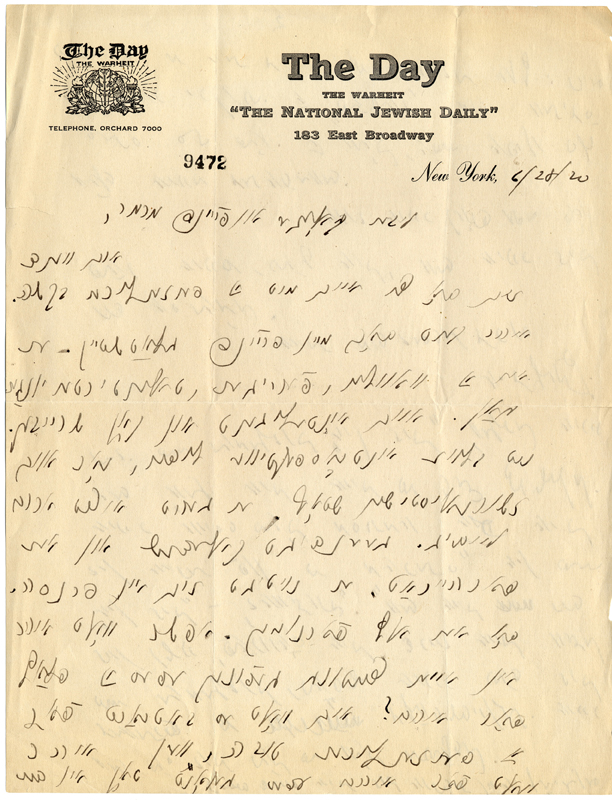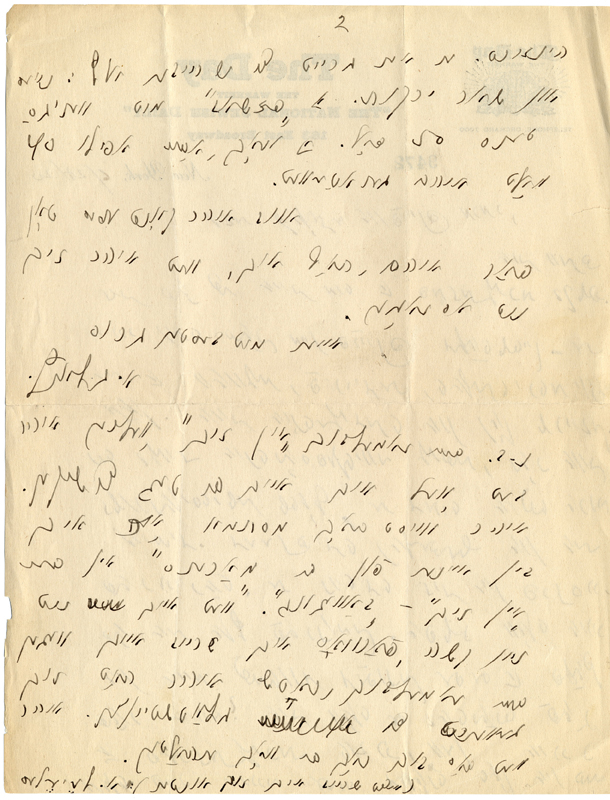Di gantse velt af a firmeblank: The World of Jewish Letterheads
Assemble the letterheads of Jewish organizations, institutions, and individuals in Europe, North and South America, and Palestine from the 1890s to the eve of World War II in 1939 and you have a portrait of the Jewish world: transnational; diverse in language, political, and religious orientation; and flourishing.
Di gantse velt af a firmeblank (The Whole World on a Letterhead) is an experiment in building that portrait. Here, we hope to bring you several times a month, a different example of letterhead from a single collection in the YIVO Archives, the Papers of Kalman Marmor.
Marmor, a Yiddish writer and cultural activist, was born October 11, 1879 in Mayshigola, Vilna Gubernia (today Maišiagala, Lithuania). In 1906, he settled in the U.S. Initially active with the Labor Zionist movement, he later became a Communist. He was an organizer of the 1937 World Yiddish Culture Congress, cultural director of the International Workers Order, and a contributor to the Communist Yiddish newspaper, Morgn Frayhayt. Between 1933 and 1936, he lived in Kiev, where he worked at the Institute of Jewish Proletarian Culture and prepared scholarly editions of the work of American Yiddish poets and writers. During Stalin’s Great Terror, the Institute was liquidated, and much of its leadership was arrested and executed. Marmor, an American citizen, returned to the U.S. He died in Los Angeles in 1956.
His papers at YIVO contain several thousand letters from the turn of the 20th century to the 1950s. He had an astonishingly diverse array of correspondents, not limited to Zionist and Communist activists.


From Aaron Glanz (Aaron Glanz-Leyeles) in New York to Kalman Marmor in Chicago, June 28, 1920. (RG 205, Folder 115)
Aaron Glanz-Leyeles was a poet, writer, and editor. His prose appeared under the name A. Glanz and his poetry under the pseudonym A. Leyeles. Together with Jacob Glatstein and Nahum Baruch Minkoff, he published In zikh (In One’s Self), the journal of the In zikhistn (sometimes translated as the Introspectivists), a group of modernist, American, Yiddish poets. The journal appeared from 1920 to 1940.
Here, Glanz-Leyeles writes to Marmor on the letterhead of The Day (Der Tog), a non-partisan, liberal Yiddish daily in New York that had recently merged with Di varhayt (The Truth). At its height in 1919, The Day reportedly had a circulation of 81,000. Glanz-Leyeles asks Marmor for a personal favor in connection with Glatstein, “a wonderful, capable, talented young man, who is also intelligent and who can write not only introspective poems but also in a journalistic style.” Glatstein has recently graduated from college and is married, but he is unemployed. Unfortunately, there are no vacancies at The Day, but maybe Marmor has something for him at the Chicago edition of the Forward? “A job for 50 dollars a week – or even 40 dollars a week – would rescue him.” (Glatstein was to go on to be one of the most revered Yiddish poets and writers in America, but this letter is just one in the record of correspondence of Yiddish writers, including even the most successful and famous, that reveals the constant struggle that all Yiddish writers went through to earn a living. Very, very few, in both Europe and America were able to sustain themselves only through their literary writing.)
Glants also promises to send Marmor a copy of the recently published In zikh poetry anthology. Marmor knows, he says, that he, Glanz is one of the “makhers” of In zikh, where he goes by the pen name, A. Leyeles.
Series curated by Roberta Newman; Images digitized by Vital Zajka. Biographical information on Kalman Marmor from biographical note by Daniel Soyer in the inventory to RG 205, Papers of Kalman Marmor.